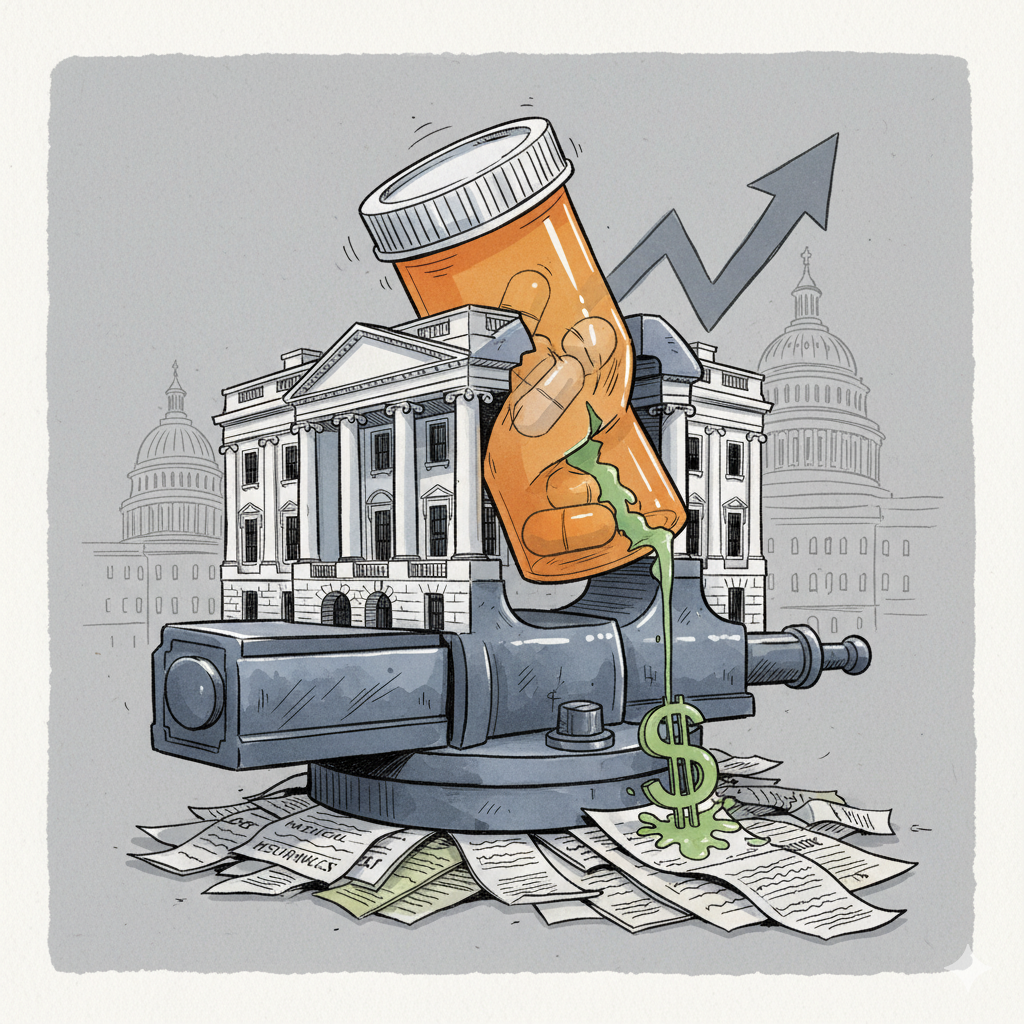The Trump-AstraZeneca Tariff Showdown and the Birth of Direct-to-Consumer Discounts

The Trump-AstraZeneca Tariff Showdown and the Birth of Direct-to-Consumer Discounts


1. Executive Summary: A Strategic Compact of Political Imperative and Commercial Pragmatism
On October 10, 2025, the Trump administration and AstraZeneca PLC announced a landmark agreement.¹ The deal aims to lower prescription drug prices for American consumers.²
This is the second agreement of its kind, following a similar pact with Pfizer Inc. in September 2025.³ It is a direct result of the administration’s aggressive “Most Favored Nation” (MFN) policy. This policy seeks to align U.S. drug prices with the lowest prices that other developed nations pay.⁴
The agreement is not a simple price reduction. It is a complex strategic maneuver, born from a convergence of political needs and commercial pragmatism.
For the Trump administration, the deal represents a tangible, high-profile victory in its war on high drug prices—a key issue for the American electorate.² For AstraZeneca, it is a calculated measure to mitigate significant risk. The company faced a credible threat from the administration of tariffs up to 100% on imported pharmaceuticals.⁵
The deal’s structure is dual-pronged. Each prong is designed to achieve distinct political and policy objectives.
The central thesis of this analysis is that the agreement’s direct impact on drug affordability for most Americans will be minimal. This includes those covered by commercial insurance or Medicare. While the deal is a significant political achievement for the Trump administration and a shrewd strategy for AstraZeneca, its tangible benefits are limited.
Multiple independent healthcare economists and policy experts support this conclusion. They note that the deal’s primary financial impact is contained within the Medicaid program. This program already benefits from substantial statutory discounts.⁸
Therefore, the deal’s true significance is not a fundamental reordering of U.S. drug pricing. Instead, it establishes a powerful new coercive framework. In this framework, the administration weaponizes trade policy to achieve healthcare policy objectives. This sets a potent precedent for all future government-industry negotiations.
As of October 2025, India has transformed its long-held semiconductor ambitions into a tangible, rapidly accelerating national mission. Driven by a coherent, state-led industrial policy and substantial fiscal incentives under the India Semiconductor Mission (ISM), the country has successfully attracted over $18 billion in investment commitments for ten strategic projects, laying the groundwork for a foundational manufacturing ecosystem. This report provides a comprehensive analysis of India’s strategy, its physical implementation, its research and development infrastructure in a global context, and the critical geopolitical risks that temper its promise as a partner for the United States.
India’s strategy is distinguished by its pragmatic focus on mature process nodes (28nm and above) and advanced packaging (ATMP/OSAT). This approach wisely avoids direct competition with leading-edge foundries in Taiwan and South Korea, instead targeting the high-volume demand from its burgeoning domestic automotive, industrial, and consumer electronics markets. Major projects, including an $11 billion fab by Tata-PSMC and a $2.75 billion packaging facility by U.S.-based Micron, are progressing rapidly, with India’s first domestically produced chips from a pilot line becoming available in late 2025.
A key component of this ecosystem is talent development. The newly approved NaMo Semiconductor Laboratory at IIT Bhubaneswar, despite its prominent name, is a tactical, regionally-focused workforce development center with a modest budget of approximately $0.6 million. Its primary role is to supply skilled personnel to specialized compound semiconductor and packaging facilities planned for the state of Odisha, not to conduct frontier research. A comparative analysis reveals it operates on a fundamentally different scale and mission from premier R&D hubs like the Albany NanoTech Complex in the U.S. or Europe’s Fraunhofer and imec, which command multi-billion-dollar investments and focus on next-generation, pre-competitive research.
From a U.S. perspective, India’s approach is complementary rather than competitive. By building capacity in mature nodes, India can de-risk global supply chains for a vast category of essential chips, allowing the U.S. to focus its CHIPS Act resources on securing the leading edge for high-performance computing and national security.
However, this opportunity is shadowed by a critical geopolitical risk. This report identifies a “Trusted Partner Paradox”: while the U.S. cultivates India as a secure and democratic alternative to China, India has simultaneously become Russia’s second-largest supplier of restricted, dual-use technologies, including microchips and machine tools essential to Moscow’s war effort in Ukraine. This activity directly undermines Western sanctions and creates a potential vector for technology leakage, posing a significant compliance and reputational risk for U.S. firms investing in India. This fundamental contradiction presents a complex challenge for U.S. policymakers, who must balance the strategic imperative of diversifying supply chains with the immediate security threat posed by India’s continued material support for a primary U.S. adversary.
(more…)
After an 𝕏 history filled with plenty of bogus ideas, my stances have obviously evolved, so consider the following my most current platform.
Don’t reform the failed systems of the past or indulge the inaction of extreme libertarianism.
Signature National Initiatives
Taxation, Revenue & An American Dividend
Economic & Financial Policy
The Black Hole of Healthcare Spending
There are staggering statistics about the current US national debt and the percentage attributed to healthcare programs like Medicare and Medicaid.
There are well-documented problems of fraud, waste, and abuse: upcoding, phantom billing, medically unnecessary procedures …
Traditional human-led audits are slow, expensive, and only catch a tiny fraction of the problem, creating a massive accountability gap.
Enter the AI Auditor, A New Paradigm for Transparency
Using advanced AI and machine learning models to analyze massive healthcare claims datasets in real-time.
AI can identify complex patterns of fraud that are invisible to human auditors: collusive networks of providers, subtle anomalies across millions of claims …
The current model is “pay and chase” … what about a future of “pre-payment verification” where AI flags suspicious claims before a single taxpayer dollar is spent?
(more…)
The risks extend beyond simple technical errors and encompass systemic vulnerabilities that could undermine the entire oversight framework.
(more…)
David’s Note: This article was substantially revised on October 12, 2025 to incorporate new research and provide a more comprehensive analysis.
Executive Summary
This report argues that the Guiding and Establishing National Innovation for U.S. Stablecoins (GENIUS) Act represents a fundamental misinterpretation of digital asset technology’s strategic value. The Act integrates stablecoins into the peacetime financial system to foster innovation. However, this policy creates a significant national security liability. It strengthens a global infrastructure that adversaries exploit for illicit finance and sanctions evasion.
The core argument is that the technology’s decisive value is not in peacetime commerce. Instead, its highest and best use is as a strategic military asset reserved for times of declared conflict. This analysis examines the GENIUS Act, the arguments of its proponents and opponents, and the extensive evidence of security threats posed by the peacetime proliferation of cryptocurrencies.
As an alternative, this report proposes a “Wartime Digital Asset Act.” This framework would restrict the peacetime use of public cryptocurrencies. It would simultaneously develop the underlying technology as a strategic military reserve. This capability would be activated only upon a declaration of war by Congress for critical applications. These include resilient command and control, secure logistics, and wartime finance.
The report concludes that true technological leadership requires the precise application of innovation to its most decisive purpose. In this case, that purpose is to serve as a reserved instrument of national power.
(more…)